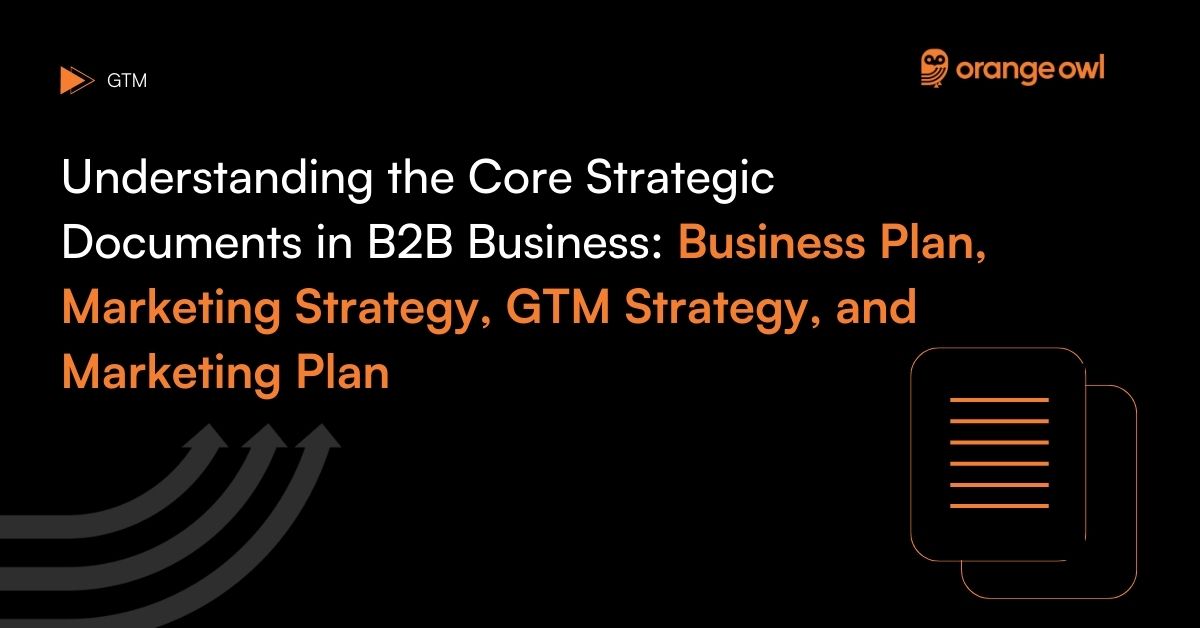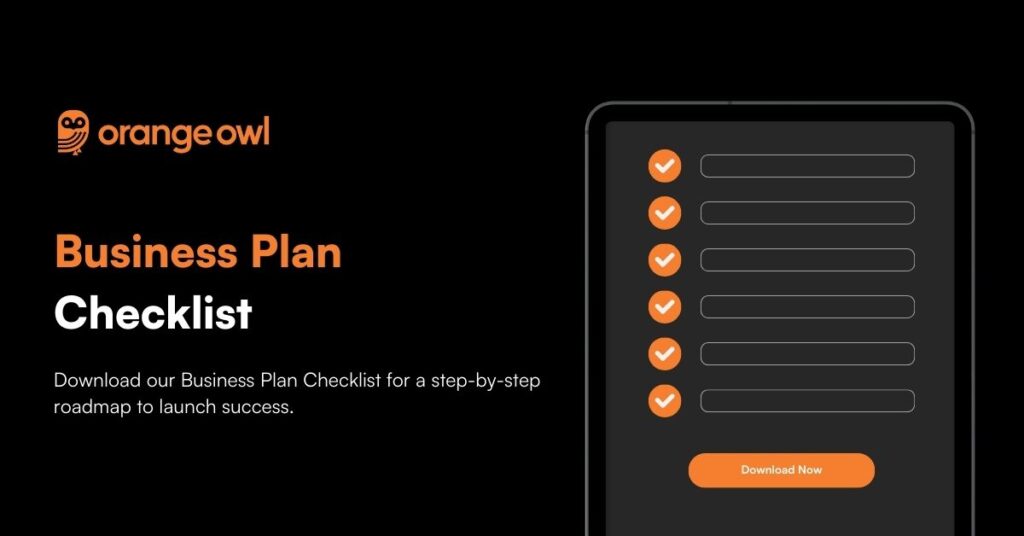Understanding the Core Strategic Documents in B2B Business: Business Plan, Marketing Strategy, GTM Strategy, and Marketing Plan
Vivek Goel
June 21, 2025

Table of Contents
In the complex landscape of B2B business operations, strategic documentation plays a critical role in guiding a company’s decisions and actions. For business leaders, understanding the distinctions and connections between a business plan, marketing strategy, GTM (go-to-market) strategy, and marketing plan is crucial for achieving synchronized business success. This blog will delve into each of these strategic documents, compare their key aspects, and provide a B2B example to clarify their practical applications.
The Four Cornerstones of Business Strategy
1. Business Plan: A business plan is a comprehensive document that provides a detailed overview of your entire business. It is a foundational tool that outlines your business’s goals, strategies for achieving them, organizational structure, and financial projections. The business plan is typically used to secure funding or investment and to set a broad strategic direction for all aspects of the business.
2. Marketing Strategy: This strategy focuses specifically on how the business intends to attract and retain customers. It includes defining the target market, developing a unique value proposition, and outlining key marketing goals. A marketing strategy is designed to align with the broader objectives outlined in the business plan and serves as a guiding framework for specific marketing activities.
3. GTM Strategy: The GTM strategy is more focused and action-oriented than the marketing strategy, primarily concentrating on successfully launching new products or services into the market. It includes detailed plans for pricing, distribution, and how to communicate with the target market. The GTM strategy ensures that new offerings are introduced in a way that maximizes their chances of market success.
4. Marketing Plan: This is a tactical document that lays out the specific actions needed to implement the marketing strategy. It details the advertising, promotions, public relations, and digital campaigns that will be used over a certain period. The marketing plan is crucial for executing the strategies laid out in the marketing strategy and often includes schedules, budgets, and performance metrics.
Comparative Analysis of Core Strategic Documents In B2B Business
Here’s a detailed comparison:
Aspect | Business Plan | Marketing Strategy | Go-To-Market (GTM) Strategy | Marketing Plan |
Purpose | Provides a comprehensive blueprint for the entire business, outlining overall business objectives | Outlines approaches for achieving specific marketing goals within the overall business plan. | Focuses specifically on delivering a product or service to market effectively | Details the specific actions needed to implement the marketing strategy. |
Scope | Broad, covering all aspects of the business including financials, operations, and marketing. | Focuses on overall marketing efforts and aligns with the business’s broader goals | Narrower than a marketing strategy, concentrated on product launch or entry into new markets | Specific, focused on executing the marketing strategy with detailed tactics and initiatives |
Time Frame | Long-term, providing a vision for the future and a roadmap for achieving it. | Medium to long-term, aligning with the lifecycle of products and the dynamics of the market | Short-term to medium-term, typically focused on the timeline of a product launch or market entry | Short-term, usually covering a fiscal year or specific campaign duration |
Key Components | Business objectives, market analysis, organizational structure, product/service line, financial plan | Target market, value proposition, key messaging, branding strategies. | Target audience, value proposition, pricing strategy, sales and distribution channels, competitive analysis | Marketing channels, budget, timeline, resources, specific marketing activities, measurement, and evaluation methods. |
Objective | To establish a foundation for the business and secure funding/investment | To guide the company’s efforts in attracting and retaining customers. | To ensure a successful product launch or market entry, optimize the product’s early market presence. | To execute specific marketing efforts that drive reach, engagement, and sales according to the strategy. |
Practical B2B Example: Launching a Project Management Software
Business Plan: A company that develops project management software outlines its business model, financial goals, market analysis, and plans for scaling operations.
Marketing Strategy: This strategy would define the target market as B2B companies needing efficient project management solutions and would outline the company’s value propositions, such as increasing project efficiency and reducing costs.
GTM Strategy: The GTM strategy for a new software version might include a pricing model, promotional offers for early adopters, and partnerships with IT consultancies to enhance market penetration.
Marketing Plan: This could detail a three-month launch campaign involving targeted LinkedIn ads, a series of webinars to demonstrate software capabilities, and email marketing to existing customers about upgrade options.
Understanding these documents and their interconnections helps in systematically planning and executing strategies that are cohesive and aligned with the company’s overarching goals. By distinguishing between these strategic layers, businesses can more effectively deploy resources and measure the success of their initiatives.
Conclusion
In conclusion, while the GTM strategy, business plan, marketing strategy, and marketing plan are all indispensable tools for guiding a company’s growth journey, they serve distinct purposes and cater to different aspects of business management. A GTM strategy is focused on the tactical execution of marketing and sales initiatives for a specific product or service launch.
A business plan provides a comprehensive roadmap for the entire business, encompassing strategic, operational, and financial aspects. A marketing strategy sets the long-term direction for achieving business goals through marketing efforts, while a marketing plan details the specific actions and resources required to execute the marketing strategy.
By understanding the differences between these, business leaders can effectively navigate the complexities of the market landscape and steer their organizations toward sustainable growth and success.
Frequently Asked Questions (FAQs) about Core strategic documents in B2B business:
A business plan provides a comprehensive blueprint for the entire business, outlining overall business objectives, strategies for achieving them, organizational structure, market analysis, and financial projections. It is often used to secure funding or investment and set a strategic direction.
While a business plan covers all aspects of a business, a marketing strategy specifically focuses on how the business intends to attract and retain customers. It includes defining the target market, developing a unique value proposition, and outlining key marketing goals that align with the broader objectives in the business plan.
A GTM (Go-To-Market) strategy includes detailed plans for pricing, distribution, target audience identification, competitive analysis, and communication strategies. It is focused on the successful launch of a new product or service into the market.
A marketing plan is a tactical document that details the specific actions needed to implement the marketing strategy. It includes advertising, promotions, public relations, digital campaigns, schedules, budgets, and performance metrics. It translates the broader marketing strategy into actionable initiatives.
For launching a project management software:
- Business Plan: Outlines business model, market analysis, and financial goals.
- Marketing Strategy: Defines target market (B2B companies), and value propositions (efficiency, cost reduction).
- GTM Strategy: Details pricing, promotional offers, and partnerships.
- Marketing Plan: Specify a launch campaign with LinkedIn ads, webinars, and email marketing.
A business plan should be reviewed and updated annually or whenever significant changes occur in the market, competitive landscape, or internal business operations. Regular updates ensure the plan remains relevant and aligned with current business conditions.
Market research provides critical insights into customer needs, market trends, competitive landscape, and potential barriers to entry. It informs the development of all strategic documents, ensuring that strategies and plans are grounded in real-world data and market conditions.
Marketing Strategy: Provides a long-term direction for achieving marketing goals, including defining the target market, value proposition, and key messaging.
Marketing Plan: Details the specific actions and resources needed to execute the marketing strategy, including campaign tactics, schedules, budgets, and performance metrics.
These documents ensure that all aspects of the business are aligned and working towards common goals. The business plan sets the overall direction, the marketing strategy aligns marketing efforts with business objectives, the GTM strategy ensures effective product launches, and the marketing plan outlines the specific actions to implement the strategy. Together, they create a cohesive roadmap for business growth and success.




